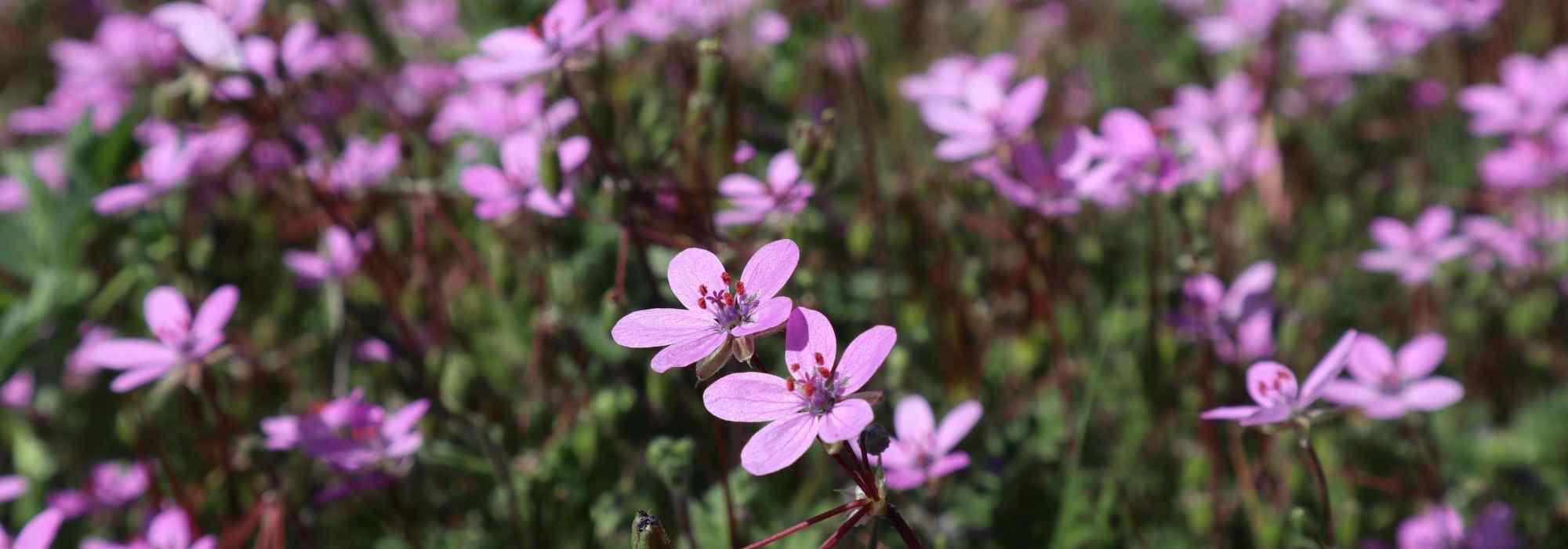
Erodium, Beak of Crane: planting, cultivation, and care
Contents
Erodium in a nutshell
- Erodium is a lovely little perennial, valued for its very long flowering period.
- Its decorative foliage, evergreen or deciduous, is fine and deeply cut, and it is also aromatic and edible.
- Hardy, it can be planted in many gardens.
- Easy to grow, it enjoys sunny locations and well-drained soils, even calcareous ones.
- It forms beautiful flowering groundcover in border beds, gravel gardens, rockeries, pots, or at the tops of walls.
The word from our expert
The Erodium is much less known than its relatives, hardy geraniums and pelargoniums. However, it is a charming little perennial groundcover with finely dissected foliage, more or less evergreen depending on the species, and topped with a long flowering period. Its small, cup-shaped flowers come in various shades of pink, white, or even yellow in some varieties, and the petals often feature fine veining or small spots that add depth to the corollas. The flowering extends from spring to autumn, thriving in full sun and well-drained soil, even clayey and calcareous.
Some varieties are annual, while others behave as perennials, and although the lifespan of Erodium can be quite short, it is a plant that often self-seeds.
Its commendable hardiness, around -15°C, makes it suitable for many gardens. Its main enemy is stagnant moisture in winter. Therefore, it requires appropriate drainage, especially in heavy soil.
Easy to grow under good cultivation conditions, this perennial, which develops rather slowly, forms a cushion about ten centimetres high for the smaller species, up to around 40 cm, adopting a fairly regular dome habit, often wider than tall.
Unfussy and able to thrive where other plants might struggle, it allows for greening up hostile areas, in stony, poor, and dry soil, but it also thrives in richer soil, provided it is not in competition with more vigorous neighbours.
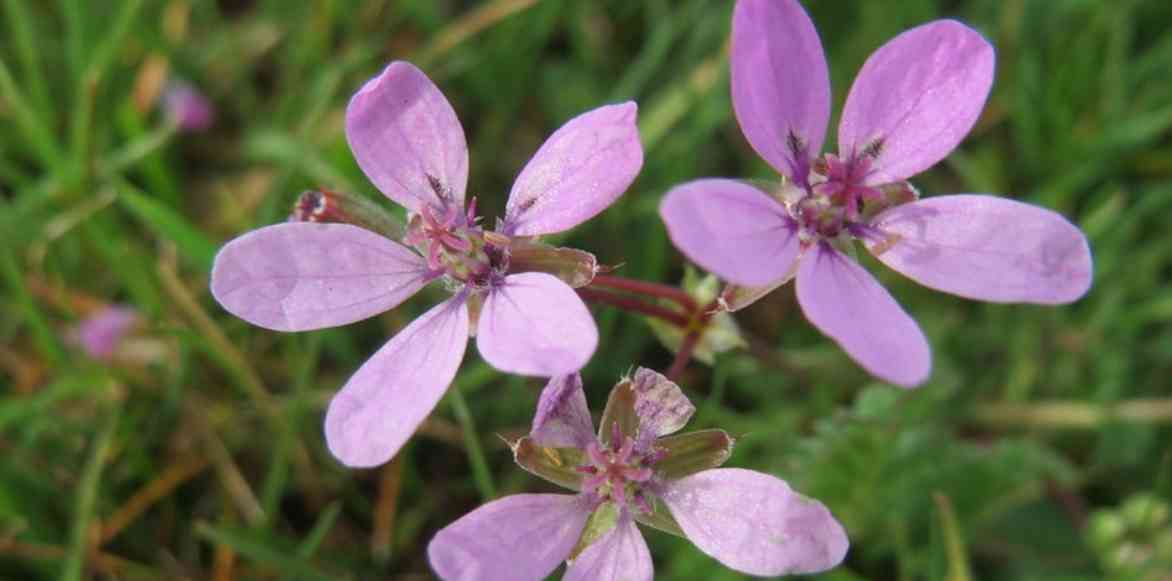
Erodium cicutarium (© Andreas Rockstein)
Description and Botany
Botanical data
- Latin name Erodium
- Family Geraniaceae
- Common name Heron's bill, crane's bill, stork's bill
- Flowering spring to autumn
- Height 15 to 40 cm
- Exposure full sun
- Soil type any well-drained soil, even dry and calcareous
- Hardiness -15°C (sensitive to winter moisture)
The Erodium genus belongs to the Geraniaceae family, just like true Geraniums (Geranium) and balcony Geraniums (Pelargonium). Its origins are varied, extending from the limestone mountains of Europe to North Africa and Central Asia. It also grows spontaneously on the American continent and in certain regions of Australia, but it is most commonly found around the Mediterranean. This genus includes perennial species as well as annual or biennial ones (such as Erodium moschatum, although rare in cultivation). Among the sixty species in this genus, notable mentions include Erodium absinthoides, Erodium cheilanthifolium, Erodium glandulosum, Erodium x kolbianum, and Erodium reichardii (also known as Alpine Geranium), but only a small number of species are commonly cultivated in gardens and available commercially; for example, Erodium chrysanthum, Erodium manescavii, Erodium variabile, Erodium trifolium, or Erodium pelargoniiflorum.
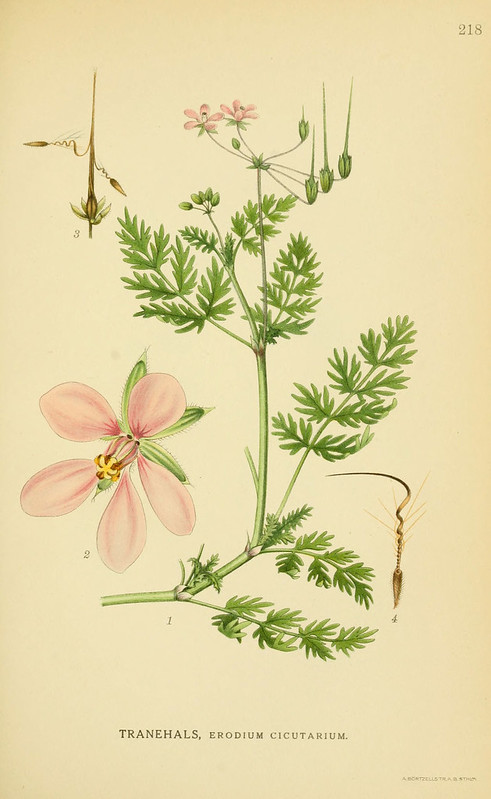
Erodium cicutarium. Botanical plate from 1920
These perennials are renowned for their ease of cultivation and very long flowering period: depending on the species and climatic conditions, flowers can be enjoyed from April until October. Carried in more or less loose bouquets (or umbels) containing several corollas, the flowers measure between 1 and 3 cm in diameter. They are round in shape, with a cup-like structure featuring 5 petals with more or less regular edges, and their colours vary, either solid or bicoloured depending on the varieties (white, pink, purple, magenta, or even yellow). These petals are highlighted with delicate veins in darker shades, and some may display coloured spots (called macules), as seen in Erodium ‘Stéphanie’. The centre of the corolla can be darker (Erodium trifolium) or lighter (Erodium variabile ‘Bishop’s Form’). The flower features 5 fertile stamens (compared to 10 for its cousin the Geranium) with anthers that are more or less yellow, pink, or orange.
The seeds, shaped like long erect beaks, give the Erodium its common name of ‘crane’s bill’ or ‘heron’s bill’. The plant, through a process called autochory, is capable of projecting its seeds nearly a metre from the parent plant. In Erodium cicutarium, or ‘Common Heron’s Bill’, the corkscrew-shaped arista extending from the seed contracts according to moisture levels, which results, once the seed is dispersed, in it being gradually driven into the soil. A surprising phenomenon that we invite you to discover in this time-lapse video.
The foliage of the Erodium contributes to the decorative effect of this lovely perennial. Deciduous, semi-evergreen, or evergreen, it comes in various shades of green (medium green, apple green, or silvery green to grey-green) and is also aromatic and edible, with a taste reminiscent of parsley. The leaves, pubescent, are oval to lanceolate, measuring between 2 and 30 cm long. They are divided into numerous leaflets, arranged in opposite pairs. More or less cut and serrated, their overall appearance can resemble that of fern or carrot foliage.
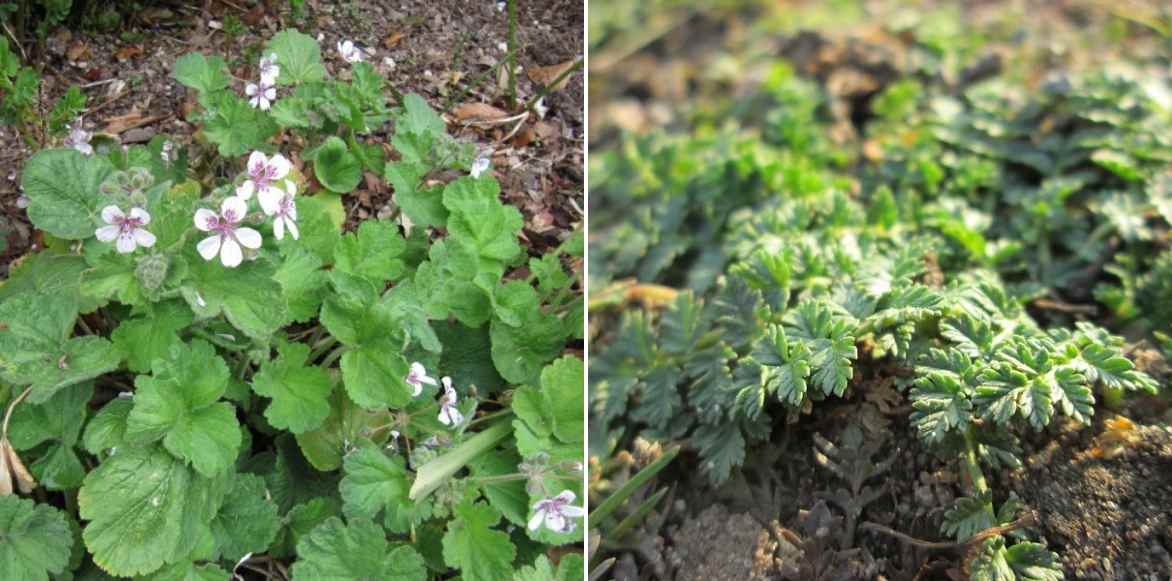
Foliage of Erodiums (© L Enking), and leaves of Erodium cicutarium (© Andreas Rockstein)
Growing rather slowly, the Erodium eventually forms a dense cushion, 10 cm to 40 cm high, with a rounded to spreading habit. Its base can become woody, and the stems can harden like young wood.
The Erodium is a full sun plant, that grows in all soils, even clayey or calcareous, as long as they are truly well-drained. This makes it an excellent candidate for well-exposed rockeries, pots, slopes and walls, or beds with filtering soil, where it will highlight the edges. In fertile soil, it poorly tolerates competition from neighbouring plants, which can eventually overshadow it. Little susceptible to diseases, its main enemy remains stagnant moisture, especially during winter. Although hardy down to -15°C, the plant indeed struggles in overly moist soil. The Erodium is relatively short-lived, but its ability to self-seed helps mitigate this drawback. Division and propagation by cuttings are also good methods to maintain young, flowering plants.
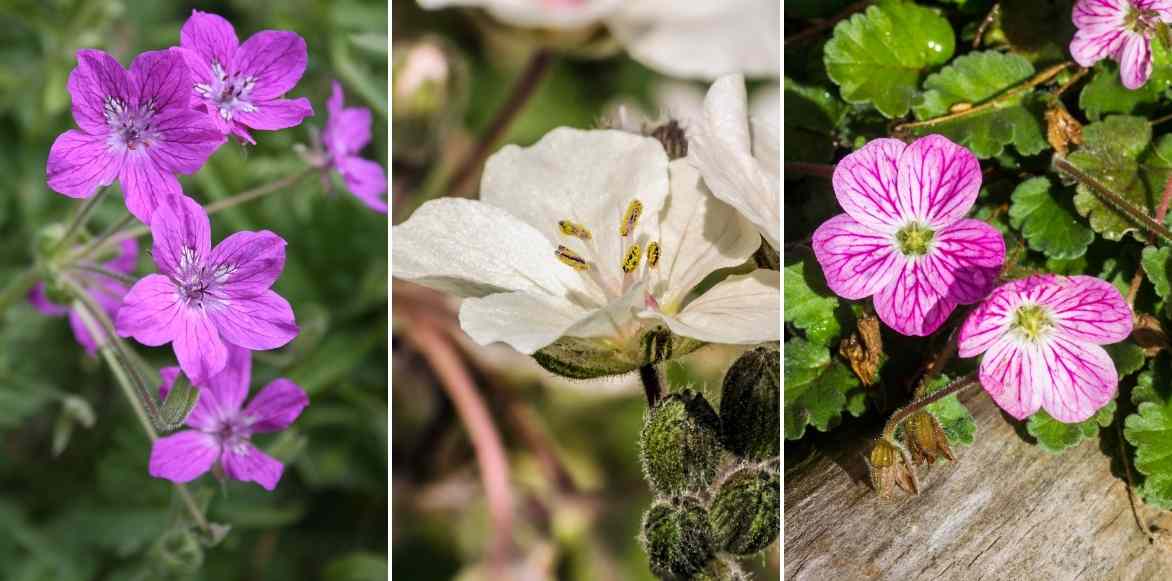
Erodium manescavi, Erodium chrysantum, and Erodium variabile
The different varieties of Erodium
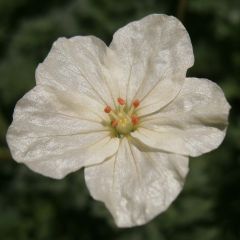
Erodium chrysanthum - Storksbill
- Flowering time July to October
- Height at maturity 15 cm
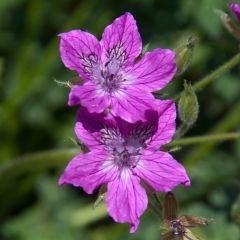
Erodium manescavii - Storksbill
- Flowering time July to October
- Height at maturity 40 cm
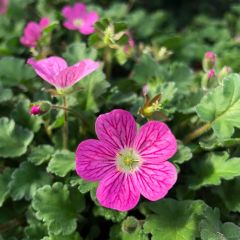
Erodium Bishops Form - Storksbill
- Flowering time June to September
- Height at maturity 10 cm
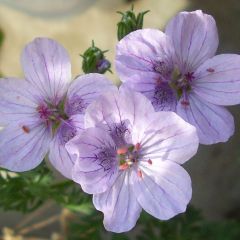
Erodium Stephanie - Storksbill
- Flowering time June to November
- Height at maturity 15 cm
Discover other Erodium - Stork's-Bills
View all →Available in 0 sizes
Available in 2 sizes
Available in 1 sizes
Available in 2 sizes
Available in 1 sizes
Available in 2 sizes
Available in 1 sizes
Available in 1 sizes
Planting
Where to plant?
Erodium is a low-maintenance perennial. It can thrive in any ordinary soil, neutral or calcareous, even dry and stony, as it withstands drought very well. What it fears most is stagnant moisture, especially in winter, although it is hardy enough to endure -15°C. It is therefore important to ensure good drainage, particularly in heavy clay soils.
Place it in full sun (possibly in partial shade in the hottest regions), in an open position.
Erodium is a groundcover, which can be used in many situations: at the edge of a sunny border, in a warm, dry, and bright rockery, at the top of a slope or retaining wall, or even in a scree garden, as well as in pots or containers to enjoy it on a terrace or balcony. Avoid planting it too close to competing plants, as they may smother it, especially in rich soil.
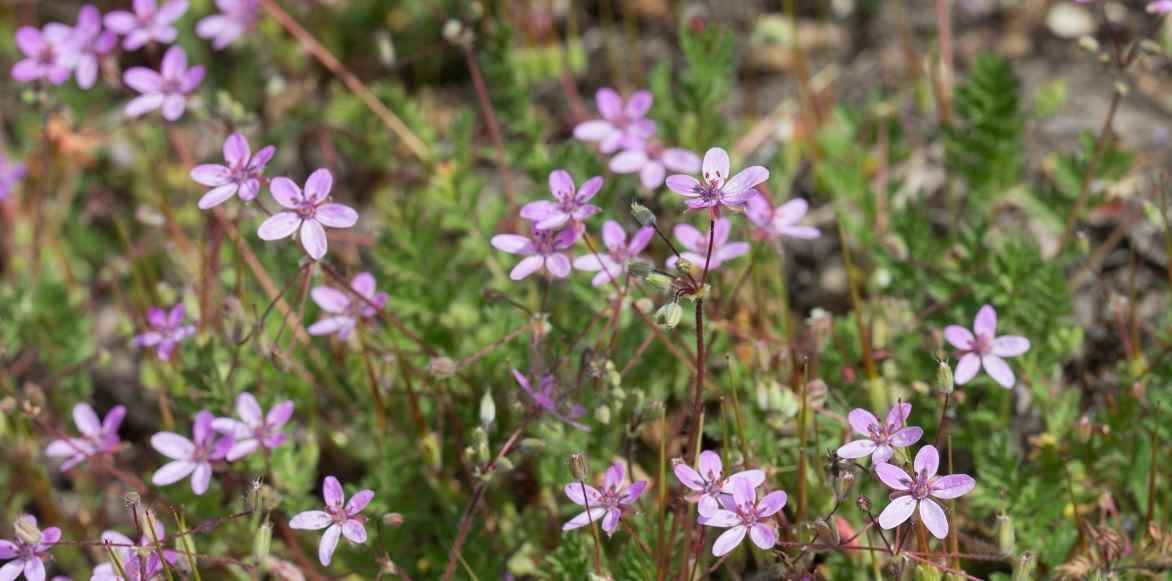 Erodiums thrive in sunny positions
Erodiums thrive in sunny positions
When to plant?
Erodium is best planted in autumn or spring. In cooler climates and fresher soils, spring may be more beneficial for successful establishment.
How to plant?
Planting in the ground
- Soak the root ball to hydrate the young plant.
- Dig a hole 2 to 3 times the size of the root ball in all directions, loosening the soil well.
- Mix a little light potting soil with your soil and a handful of compost to help it settle in.
- In heavy soil, incorporate a drainage element into your substrate (gravel, pumice, coarse sand…) to prevent water from stagnating too long at the collar and roots.
- Remove your Erodium from its pot and position it so that the collar (the junction between the aerial and underground parts) is level with the soil. If the plant appears not to have developed foliage yet, align the top of the root ball with the soil level.
- Water generously, even if it rains, to ensure good contact between the soil and the roots.
- Mulch around the plant, favouring filtering materials (gravel, pumice…).
- Monitor watering in the first few weeks. The soil should not dry out. Natural rainfall may be sufficient, so avoid overwatering the plant.
- If planting multiple plants, allow about 25 cm between each one.
Planting in pots
- Soak the pot to saturate the potting soil with water.
- Choose a pot of sufficient size (at least 30 cm), with a drainage hole at the bottom.
- Place a layer of 3 or 4 cm of gravel or pumice at the bottom of the pot to ensure good drainage.
- Fill the pot with quality potting soil, possibly mixed with a handful of compost.
- To ensure good water drainage, you can also mix a handful of the same drainage material used at the bottom of the pot into your substrate.
- Fill the pot with your mixture, leaving enough space to place your Erodium.
- Remove your young plant from its pot and place it in the centre of the pot, then fill in with your mixture. Firm down, without burying the collar.
- Water thoroughly to moisten the entire substrate.
- Add an additional layer of drainage as mulch around the plant, about 2 cm thick.
- Allow the potting soil to dry slightly between waterings, and place your pot in a warm, bright position.
→ Learn more about growing Erodium in pots in our advice sheet!
Read also
10 perennial plants for calcareous soilMaintenance and Care
Erodium is a hardy perennial that requires minimal maintenance. In summer, to prolong the flowering, you can cut the faded stems back to the ground. Leave a few to set seed if you wish to enjoy spontaneous sowing, although the resulting plants may differ from the parent. At the end of winter, clean up any dry and damaged parts and refresh the mulch if necessary. In early spring, pinching the young stems helps them to ramify.
If you are growing your plant in open ground, there is no need to feed it, as Erodium is an undemanding perennial. In pots, a small amount of compost in spring can be beneficial.
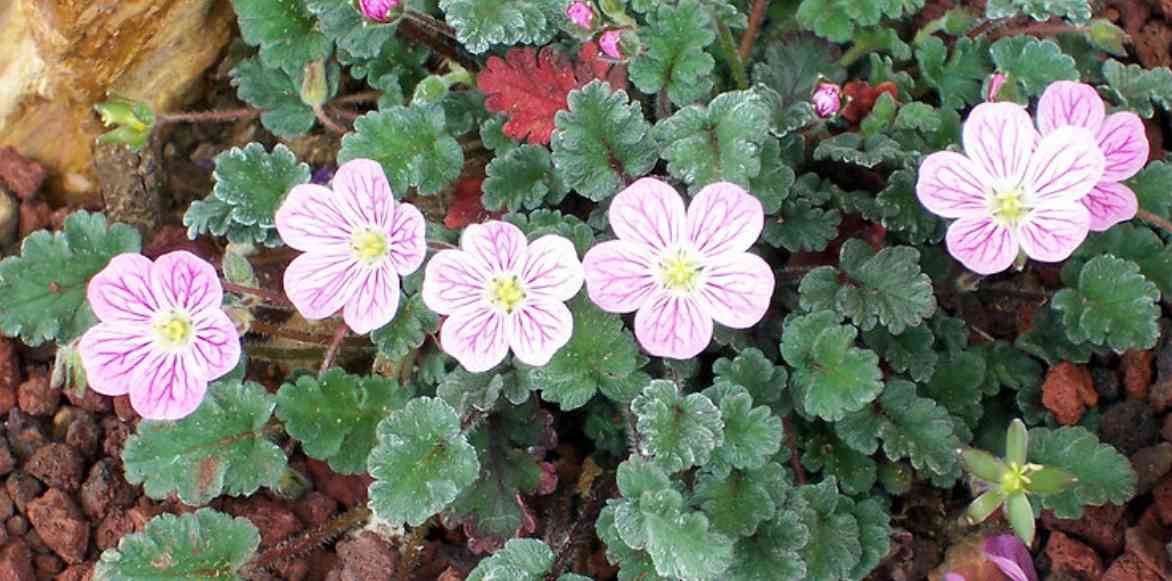
Erodiums (© Peter Standish)
Multiplication
Some Erodium species multiply easily by sowing, such as Erodium cicutarium or E. trifolium. However, except for annual species and botanical species, the results may vary from the original plant. In this case, it is preferable to proceed with division or propagation by cuttings.
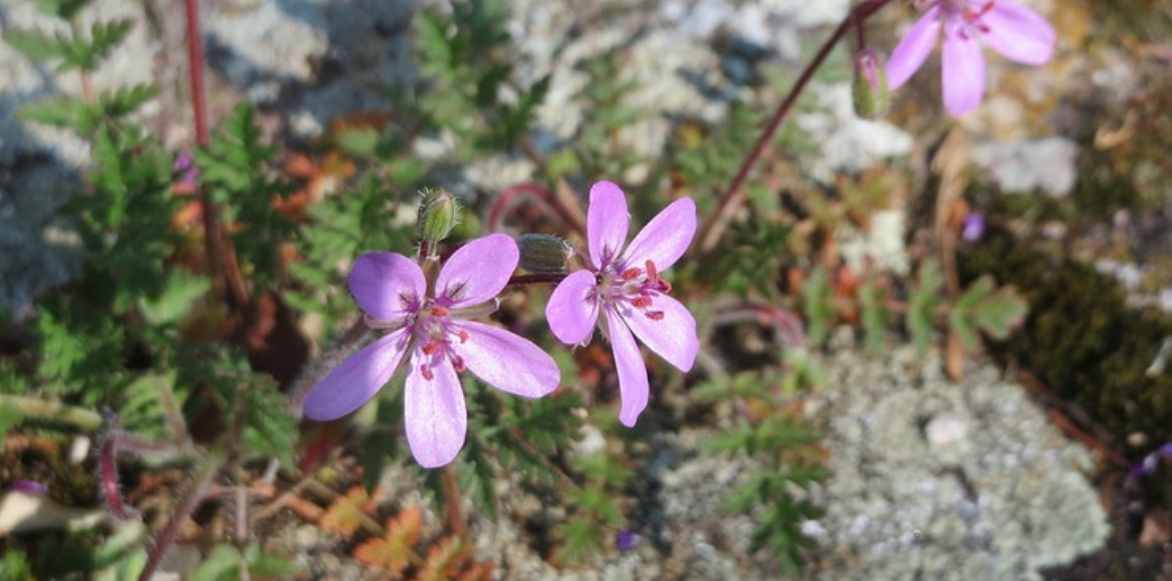
Erodium cicutarium (© Andreas Rockstein)
Sowing
Some species self-seed spontaneously, but you can also collect mature seeds and sow them.
1) Fill a seed tray with light potting soil, mixed with coarse sand to ensure good drainage.
2) Spread the seeds on the surface, then cover with a thin layer of potting soil.
3) Firm down with a small board, and water with a very fine spray to avoid disturbing the seeds. Another option is to immerse your tray in a container filled with water and let the substrate soak up moisture by capillarity.
4) Place the tray in a bright location but out of direct sunlight, at a temperature of around 20°C. The potting soil should remain moist but not waterlogged.
5) As soon as the seeds have produced their first true leaves, transplant the young plants into individual pots filled with potting soil and sand, then water.
6) Once the root system has developed sufficiently, you can plant your new plants in the ground.
Division
Division allows you to rejuvenate clumps and obtain plants identical to the mother plant. Perform this in spring on mature, well-established plants.
1) Lift the plant to be divided using a spade, taking care to damage the roots as little as possible.
2) After removing as much soil as possible from the roots, divide the plant, ensuring that each division includes both roots and stems.
3) Replant each division in the desired location, water, and mulch.
4) Do not let the soil dry out too much in the first few weeks after planting, to allow the plant time to develop a new root system.
Propagation by Cuttings
Propagation by cuttings is a method that allows you to produce several plants from a mother plant without needing to dig it up. This operation is carried out in spring when the stems have started to grow.
1) Take cuttings of about ten centimetres, cutting just below a node.
2) Remove all leaves from the cutting, keeping only those at the top.
3) Place the cuttings in small individual pots filled with light, well-draining potting soil, mixing in coarse sand if necessary.
4) Firm the soil around the cutting and water.
5) Place your pots in a bright location, but out of direct sunlight. Ideally, you should place them under a small frame, or if not possible, cover the cuttings with a transparent plastic bag or a half plastic water bottle with the bottom cut off.
6) Ensure the potting soil remains moist but not waterlogged.
7) When the cuttings produce new leaves, remove the plastic or half bottles.
8) Once the young plants have developed enough roots, you can plant them in their final location.
Associate Erodium
Erodium can be paired with many plants that, like it, thrive in rather dry, calcareous soils, in warm and sunny exposures.
Depending on the growth of the plants you choose, be sure to leave your Erodium enough space to develop properly, as some neighbours may eventually outgrow its more modest growth, especially in rich soil.
- Its preference for well-drained soils makes it a perfect plant for a scree garden, alongside Fleabanes, Spurge, Gauras, or even Agapanthus and Sedums. Feel free to tuck these perennials among some bushes like Cistus, Lantanas (in mild climates) or Rosemary, which have lovely volumes. Some grasses add a beautiful touch of lightness: some have a fairly low growth habit and evergreen foliage, like Fescues and Helictotrichons, with their beautiful blue foliage, which pair wonderfully with the pink flowers of Erodium.
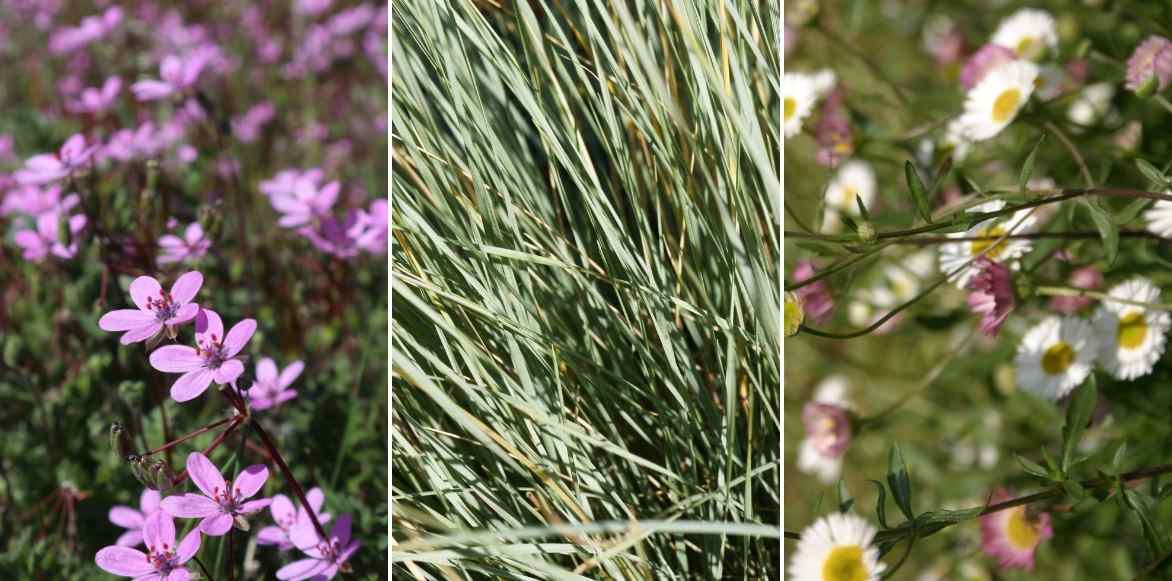
A rock garden association, with Helictotrichon and Erigerons karvinskianus
- Due to its small size, Erodium beautifully dresses the edges of sunny borders, alongside other perennials, such as Iberis sempervirens, Pinks or Phlox subulata. At the back, install taller perennials with strong graphic qualities, two traits offered by Eryngiums, Echinops or Onopordum. Also play with the silver-grey or more blue foliage of Lavenders, Phlomis or Ballota. Here again, the movement of grasses dancing in the wind adds a welcome poetry to the display. Candidates like Stipa (Angel Hair, Giant Stipa, Stipa arundinacea) or Panicums are good examples.
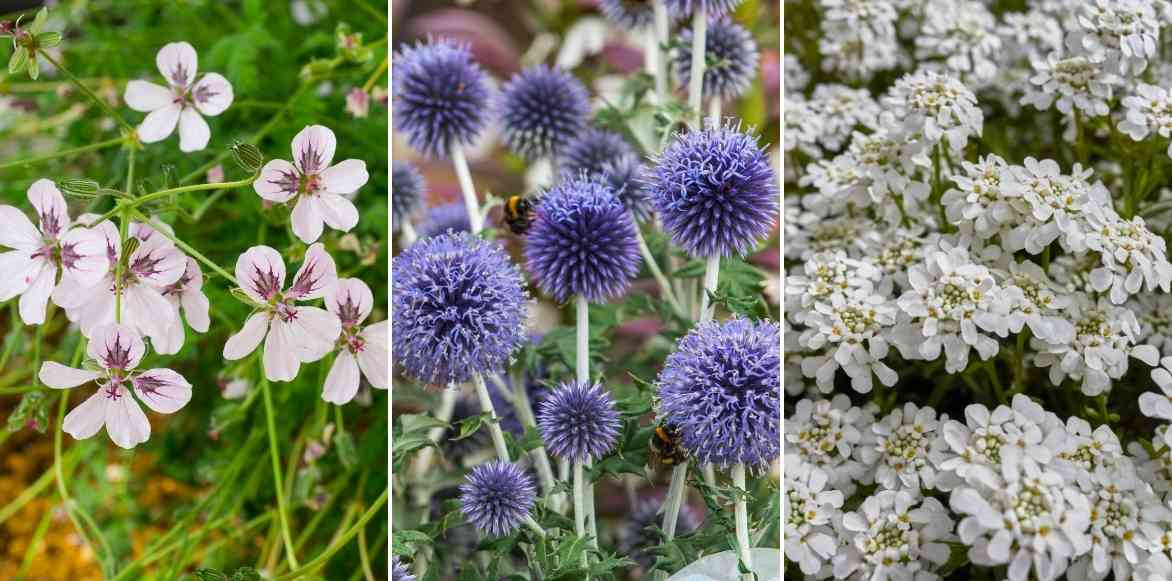
A sunny border association with Echinops and Iberis sempervirens
- Erodium is also well-suited for use in stone troughs, for example, just like some Agaves, creeping Sedums or Houseleeks.
- Don’t forget to scatter some spring-flowering bulbs. Ornamental Alliums, Muscari, Crocus, Iris and other Daffodils and Tulips bring spring cheer and allow you to wait for the perennials to display their colours.
→ More association ideas with Erodiums in our advice sheet!
Useful resources
- Find our different varieties of Erodium on our site.
- Also discover their cousins, hardy geraniums and Pelargonium.
- Subscribe!
- Contents































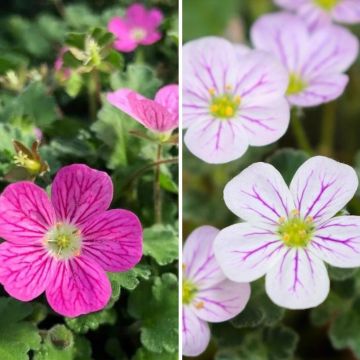
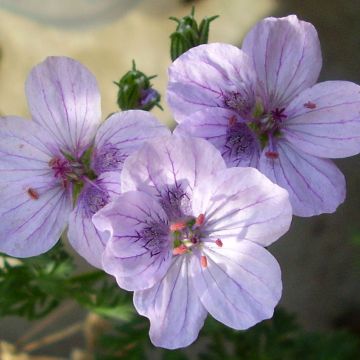
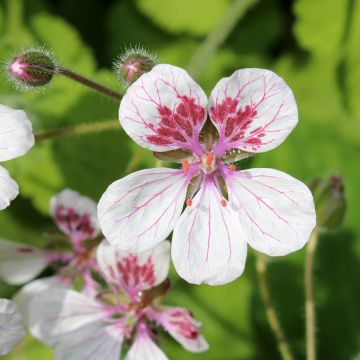



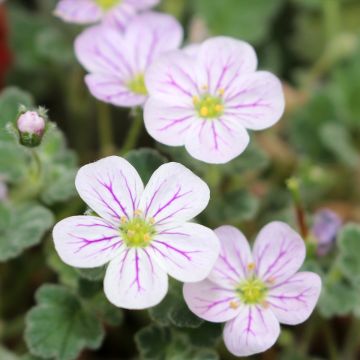

Comments